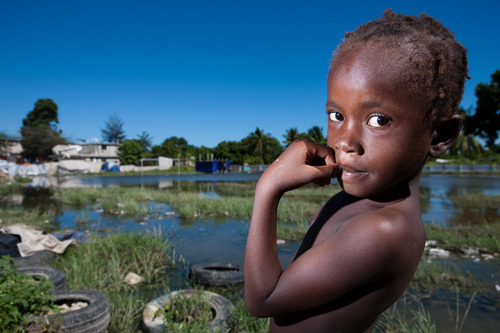
© IOM 2010 (Photo by Daniel Desmarais)
Here’s The Thing
By Bradley Mellicker,
Disaster Risk Reduction specialist
Port-au-Prince, Haiti
JUST before the arrival of Hurricane Sandy last year, millions of extremely vulnerable individuals in Haiti — both those in post-earthquake IDP sites as well as those in other areas — prepared the best they could for the unpredictable effects of the coming storms. Tropical cyclones can cause very high loss of human life and near-catastrophic damage in a country with near 99% deforestation, extremely limited economic opportunity, inadequate infrastructure, continuing displacement from the 2010 earthquake and other factors. Underlying vulnerabilities in Haiti frequently cause a level of damage far disproportionate to that in neighbouring countries.
But here’s the thing: In Haiti, despite the extreme level of vulnerability tropical storms and hurricanes, organized, preventive evacuations — the norm in other countries prone to such storms — were virtually non-existent in Haiti. Instead, vulnerable populations were left with few, if any, options, and were forced to ride out the storms in very dangerous situations, only trying to evacuate during the worst of the storm.
The 2012 hurricane season, however, gave the Haitian government and some of its most vulnerable populations the opportunity to put into practice a newly-developed system of short-term, preventive evacuations. Distinct from collective centres for internally displaced persons, these shelters are designed to provide safe shelter temporarily, during the passage of the storm.
The development of this system, although still in its infancy, is the direct result of extensive IOM leadership and technical support to Haitian Civil Protection, the Haitian Red Cross, civil society and vulnerable populations themselves. Since the 2010 earthquake, IOM constructed or rehabilitated nearly 30 evacuation shelters, assisted the Government in developing its first-ever guidelines on short-term evacuations, supported post-earthquake structural evaluations by the Ministry of Public Works of hundreds of other potential shelters and provided direct logistical and operational support for evacuations of up to 10,000 people.
Beginning in the days before the storms, IOM teams worked tirelessly, helping GoH to finalize evacuation plans, prepare shelters, sensitize vulnerable populations and conduct the evacuations themselves. In both cases, all evacuees left the shelters immediately after the storm, leaving schools used as shelters in good condition. By many observers, this was considered unlikely and a potential threat to the success of such evacuations.
In the cases of both Isaac and Sandy, however, IOM helped show skeptics that such a system could work in a context as difficult as Haiti, that in every difficulty there is an opportunity to improve, to prepare better for the next time, to continue working to minimize the impact of ever-worsening tropical cyclones on an increasingly-vulnerable population.
IOM Haiti’s work on the issue of evacuation shelters comprises one pillar of its Disaster Risk Reduction and Emergency Preparedness / Response programme. In addition, IOM supports Government in activities designed to reduce the physical risk faced by vulnerable population. This takes place primarily through reforestation, soil conservation and drainage works designed to reduce flooding. Over the past years, IOM has built, rehabilitated, treated or otherwise improved hundreds of kilometers of watercourses in the country.
Finally, IOM engages directly with Haitian civil protection, Haitian Red Cross, civil society and other local actors to improve the preparation and response capacities of vulnerable communities. This includes the training of thousands in basic first aid, community mitigation, basic early warning systems, evacuation procedures and related subjects.